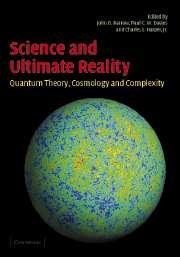Book contents
- Frontmatter
- Contents
- List of contributors
- Foreword
- Editors' preface
- Preface
- Acknowledgments
- Part I An overview of the contributions of John Archibald Wheeler
- Part II An historian's tribute to John Archibald Wheeler and scientific speculation through the ages
- Part III Quantum reality: theory
- Part IV Quantum reality: experiment
- 11 Why the quantum? “It” from “bit”? A participatory universe? Three far-reaching challenges from John Archibald Wheeler and their relation to experiment
- 12 Speakable and unspeakable, past and future
- 13 Conceptual tensions between quantum mechanics and general relativity: are there experimental consequences?
- 14 Breeding nonlocal Schrödinger cats: a thought-experiment to explore the quantum–classical boundary
- 15 Quantum erasing the nature of reality: or, perhaps, the reality of nature?
- 16 Quantum feedback and the quantum–classical transition
- 17 What quantum computers may tell us about quantum mechanics
- Part V Big questions in cosmology
- Part VI Emergence, life, and related topics
- Appendix A Science and Ultimate Reality Program Committees
- Appendix B Young Researchers Competition in honor of John Archibald Wheeler for physics graduate students, postdoctoral fellows, and young faculty
- Index
15 - Quantum erasing the nature of reality: or, perhaps, the reality of nature?
from Part IV - Quantum reality: experiment
Published online by Cambridge University Press: 29 March 2011
- Frontmatter
- Contents
- List of contributors
- Foreword
- Editors' preface
- Preface
- Acknowledgments
- Part I An overview of the contributions of John Archibald Wheeler
- Part II An historian's tribute to John Archibald Wheeler and scientific speculation through the ages
- Part III Quantum reality: theory
- Part IV Quantum reality: experiment
- 11 Why the quantum? “It” from “bit”? A participatory universe? Three far-reaching challenges from John Archibald Wheeler and their relation to experiment
- 12 Speakable and unspeakable, past and future
- 13 Conceptual tensions between quantum mechanics and general relativity: are there experimental consequences?
- 14 Breeding nonlocal Schrödinger cats: a thought-experiment to explore the quantum–classical boundary
- 15 Quantum erasing the nature of reality: or, perhaps, the reality of nature?
- 16 Quantum feedback and the quantum–classical transition
- 17 What quantum computers may tell us about quantum mechanics
- Part V Big questions in cosmology
- Part VI Emergence, life, and related topics
- Appendix A Science and Ultimate Reality Program Committees
- Appendix B Young Researchers Competition in honor of John Archibald Wheeler for physics graduate students, postdoctoral fellows, and young faculty
- Index
Summary
Introduction
WHY must I treat the measuring device classically? What will happen to me if I don't?!
Eugene WignerThe quantum measurement problem – how does an apparently “classical” definite world arise out of the random world of quantum superpositions – was and continues to be one of the fundamental philosophical issues in quantum mechanics. What we mean by a classical world, for example, is one in which macroscopic objects are not in superposition states of being simultaneously in several locations at once, and cats are never in coherent superpositions of being alive and dead. This lack of coherence is actually a loss of the coherence that exists at the level of the isolated quanta, but somehow does not survive the transition to the classical level of measuring apparatus. Such incoherent states are known as mixed states. Therefore, to study the quantum–classical interface, or even to investigate whether such an interface exists at all other than in the minds of “classical sympathizers,” one should look carefully at mixed states, how they arise and how they behave. Here we describe a set of experiments, both real and gedanken, investigating the subtleties of quantum interference when mixed states are involved. We start by describing the well-known double-slit experiment, and the loss of interference when which-path information can be had.
- Type
- Chapter
- Information
- Science and Ultimate RealityQuantum Theory, Cosmology, and Complexity, pp. 306 - 328Publisher: Cambridge University PressPrint publication year: 2004
- 5
- Cited by

